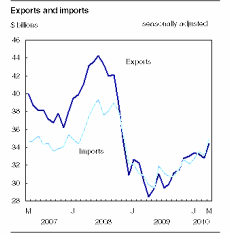

The trade balance remained off-kilter, but Canadian importers and exporters notched strong growth in May, according to Statistics Canada.
Canada’s merchandise imports increased 5.7 percent in May from April, while exports were up 5.2 percent.
Over the course of the month Canadian organizations imported merchandise worth $35 billion, up from $33.1 billion in April. May exports were worth $34.5 billion, up from $32.8 billion the previous month.
“Price increases boosted the numbers, but a surge in physical shipments of goods was the main source of growth in the month,” commented Peter Hall, vice-president and chief economist at Export Development Canada.
However, since imports increased more aggressively than exports, Canada posted a trade deficit with the rest of the world of $503 million, expanding on a $330-million deficit in April.
Widespread import growth
Several sectors were responsible for the strong growth in imports.
Consumer goods imports grew 9.3 percent, with products like medicinal and pharmaceutical products accounting for much of the gain.
Imports of industrial goods and materials were up 6.8 percent, largely thanks to more activity in ores, precious metals and metal fabricated products.
Imports of machinery and equipment climbed 6.6 percent from April, representing the fourth consecutive month of increases. Office machines and equipment imports were particularly high, increasing 19.8 percent month-over-month.
When it came to automotive products, imports were up 4.8 percent. Motor vehicle parts made up more than two-thirds of the gain in the sector.
Autos lead exports
Even though imports outpaced exports, there was plenty of good news on the export front in May.
Exports of automotive products grew a remarkable 20.8 percent month-over-month, building on steady improvements since hitting a low in early 2009. Passenger autos were particularly strong, growing 28.1 percent to $3.7 billion—the highest level since January 2006. Motor parts exports grew for the seventh consecutive month, ending May 9.6 percent ahead of April.
Hall commended the sector’s “standout” performance: “The gain comes in spite of the fact that US auto sales remain suppressed. Canada is blessed with models that happen to be selling well stateside,” he said.
Exports of agricultural and fishing products increased six percent, with higher exports of meat, wheat and other food playing a big role.
Exports of machinery and equipment increased 4.6 percent. Lower exports of aircraft, engines and parts mitigated the growth in this area.
And the battered energy sector changed course from three months of export declines, notching an increase of 1.6 percent on the backs of increased exports of natural gas, petroleum and coal.
In conclusion
Hall offered a cautious take on what May’s numbers will mean for importers and exporters going forward.
“Canada’s latest trade data buck the weakening trend that has recently beset many international indicators,” he said.
“However, it is difficult to imagine that if global weakening persists, Canada will continue to crank out May-style numbers. Import data point to persistent strength in the domestic market, a welcome feature of the current global downturn, and still something of a mystery.”
Francis Fong, economist with TD Economics, said the trend towards a stronger domestic market is not unique to Canada.
Advertisement

